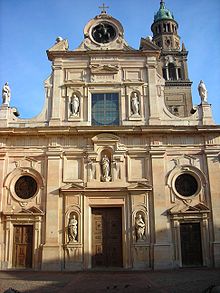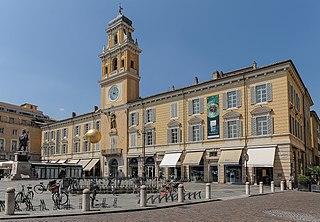
Parma is a city in the northern Italian region of Emilia-Romagna known for its architecture, music, art, prosciutto (ham), cheese and surrounding countryside. With a population of 198,292 inhabitants, Parma is the second most populous city in Emilia-Romagna after Bologna, the region's capital. The city is home to the University of Parma, one of the oldest universities in the world. Parma is divided into two parts by the stream of the same name. The district on the far side of the river is Oltretorrente. Parma's Etruscan name was adapted by Romans to describe the round shield called Parma.

Ottavio Farnese reigned as Duke of Parma and Piacenza from 1547 until his death and Duke of Castro from 1545 to 1547 and from 1553 until his death.

Piacenza is a city and comune in the Emilia-Romagna region of northern Italy, and the capital of the eponymous province. As of 2022, Piacenza is the ninth largest city in the region by population, with over 102,000 inhabitants.
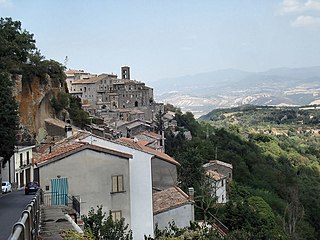
Bomarzo is a town and comune of the province of Viterbo, in the lower valley of the Tiber. It is located 14.5 kilometres (9.0 mi) east-northeast of Viterbo and 68 kilometres (42 mi) north-northwest of Rome.

The Duchy of Parmaand Piacenza, was an Italian state created in 1545 and located in northern Italy, in the current region of Emilia-Romagna.

GiacomoBarozzida Vignola, often simply called Vignola, was one of the great Italian architects of 16th century Mannerism. His two great masterpieces are the Villa Farnese at Caprarola and the Jesuits' Church of the Gesù in Rome. The three architects who spread the Italian Renaissance style throughout Western Europe are Vignola, Serlio and Palladio. He is often considered the most important architect in Rome in the Mannerist era.

Ranuccio I Farnese reigned as Duke of Parma, Piacenza and Castro from 1592. A firm believer in absolute monarchy, Ranuccio, in 1594, centralised the administration of Parma and Piacenza, thus rescinding the nobles' hitherto vast prerogative. He is best remembered for the "Great Justice" of 1612, which saw the executions of a large number of Piacentine nobles suspected of plotting against him. Claudia Colla his mistress and her mother were accused of using witchcraft to stop him from having offspring, and both were sentenced to death by burning. Because one of the conspirators, Gianfrancesco Sanvitale, falsely implicated several Italian princes, namely Vincenzo Gonzaga, Duke of Mantua and Cesare d'Este, Duke of Modena, in the plot, Vincenzo and Cesare's names appeared on the list of conspirators during formal court proceedings; as a result, Ranuccio's reputation among the rulers of Italy was irreparably damaged because it was evident that he gave credence to Gianfrancesco's obviously false confession. When, consequently, in the early 1620s, Ranuccio was looking for a bride for his younger legitimate son and heir, Odoardo, none of the Italian ruling families were forthcoming with princesses.

The House of Farnese was an influential family in Renaissance Italy. The titles of Duke of Parma and Piacenza and Duke of Castro were held by various members of the family.

Palazzo Farnese is a palace in Piacenza, northern Italy.
Pier Francesco Orsini, also called Vicino Orsini, was an Italian condottiero, patron of the arts, and duke of Bomarzo. He is famous as the commissioner of the Mannerist Park of the Monsters in Bomarzo.
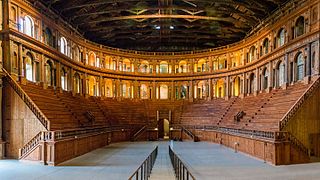
Teatro Farnese is a Renaissance theatre in the Palazzo della Pilotta, Parma, Italy. It was built in 1618 by Giovanni Battista Aleotti. The idea of creating this grand theater came from the Duke of Parma and Piacenza Ranuccio I Farnese. The theatre was almost destroyed by an Allied air raid during World War II (1944). It was rebuilt and reopened in 1962.
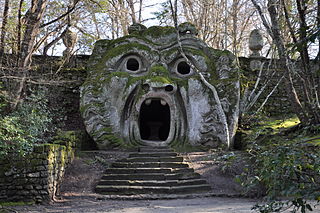
The Sacro Bosco, colloquially called Park of the Monsters, also named Garden of Bomarzo, is a Mannerist monumental complex located in Bomarzo, in the province of Viterbo, in northern Lazio, Italy.
Giovanni Battista Magnani was an Italian architect working entirely in Parma in the first half of the 17th century. He was the most successful of a family of masons and architects that included his father Nicostrato and his son Carlo.

Gerolama Orsini (1504–1569) sometimes Girolama Orsini was the Duchess of Parma as the wife of Pier Luigi Farnese, Duke of Parma. She served as Regent (Governor) of the Ducky of Castro in the name of her son Orazio, Duke of Castro between 1550 and 1553.

Pietà with Saints Clare, Francis and Mary Magdalene is a 1585 oil on canvas painting by Annibale Carracci, now in the Galleria nazionale di Parma.

The Palazzo del Giardino or Palazzo Ducale del Giardino is a historic palace in the Parco Ducale in Parma. It is not to be confused with the official Parma residence of Marie Louise, Duchess of Parma between Palazzo della Pilotta and Palazzo della Provincia in what is now known as piazzale della Pace - she also lived at the Ducal Palace of Colorno and in the Casino dei Boschi in Sala Baganza. The main Ducal Palace in Parma, the Palazzo della Pilotta and the Reinach Theater were all destroyed in bombing on 13 May 1944.
Giovanni Boscoli was an Italian Renaissance sculptor and architect, also known as Nanni da Montepulciano after his birthplace of Montepulciano. His father Tomaso was also an architect.

Vittoria Farnese, also known as Vittoria, Princess of Parma, and by her married name Vittoria Farnese della Rovere, was an Italian noblewoman, Duchess consort of Urbino from 1548 until 1574 by marriage to Guidobaldo II della Rovere, Duke of Urbino.

Portrait of Cardinal Alessandro Farnese is a c. 1545 – 46 oil on canvas three-quarter-length portrait of Alessandro Farnese the Younger (1520-1589) by Titian, now in the Museo nazionale di Capodimonte in Naples.

